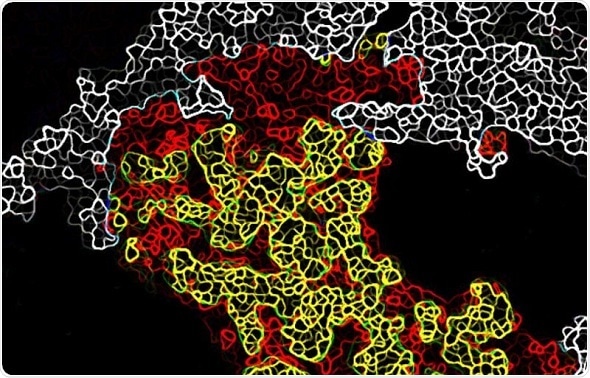Image showing how cancer cells affect the cells around them. Metastatic breast cancer cells, which have been tagged with a yellow protein, are able to mark neighboring healthy cells in red. Untouched healthy cells are shown in white. Credit: Ilaria Malanchi
Our new technique allows us to study changes to cells in the tumor microenvironment with unprecedented precision. This helps us to understand how these changes relate to tumor growth and metastasis, allowing us to develop better strategies to treat the disease.
We discovered that non-cancerous cells in the tumor microenvironment regress back into a stem-cell like state, and actually support cancer growth. By corrupting its neighbors, cancer transforms its local environment to support its own survival.”
Ilaria Malanchi, The Francis Crick Institute
Colorful cancer marker
This new technique relies on cancer cells engineered to release a cell-penetrating fluorescent protein that gets taken up by its neighboring cells. These color-labeled cells can be identified and compared to other (unlabelled) cells that have not come into contact with the tumor. Researchers in Ilaria’s lab used this approach in mice to study the cells around breast cancer that had spread to the lungs. Data from Alessandro Ori's lab at the Fritz Lipmann Institute in Germany confirmed that the labeled cells produced different proteins to unlabelled cells.The researchers found labeled cells from the lung to have stem cell-like features, unlike the lung cells found outside of the tumor microenvironment. The team showed that those cells from the mouse lungs supported tumor growth when mixed with tumor cells in 3D culture in the lab, suggesting that they help the cancer to survive and grow.
Stem cells to mini lungs
In order to further test the potential of the stem-cell like cells in the tumor microenvironment, Ilaria teamed up with Joo-Hyeon Lee at the Wellcome-MRC Stem Cell Institute, who used them to grow lung organoids, or ‘mini-lungs’.The unlabelled healthy lung cells formed mini-lungs, mostly made up of alveolar epithelial cells which line the lung’s alveoli - the tiny sacs where gas exchange takes place. By comparison, the labeled cells taken from the tumor microenvironment unexpectedly formed mini-lungs with a wider range of cell types.
To our amazement, we found that cells receiving proteins from adjacent cancer cells obtained stem-cell-like features. They could change their fate to become different cell types. It demonstrates the powerful influence that cancer exerts over its neighboring cells, making them liable to change easily.”
Joo-Hyeon Lee, joint senior author of the paper
The researchers hope that their approach will be used by other scientists looking to gain a deeper understanding of the local changes triggered by cancer which help it to survive, spread and develop resistance to treatments.
The potential applications are not confined to cancer - a similar approach could enable scientists to study interactions between different cell types in the body.
The Francis Crick Institute







No comments
Post a Comment